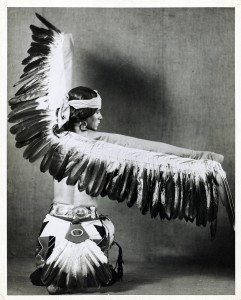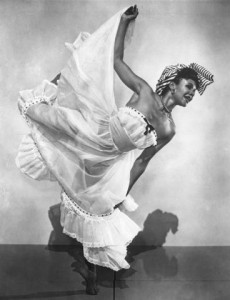Dance After the Heroic Age: The Second Generation
![]() Guide: Modern Dance in America
Guide: Modern Dance in America
Martha Graham, Doris Humphrey, Charles Weidman, and Hanya Holm, know as the “big four” choreographers of the ‘30s and ‘40s—as well as composer/critic Louis Horst—established training programs for dancers (often the dancers in their own companies, who would perform their work) in or before the mid-‘30s. They distilled and passed on a distinctive set of aesthetic frameworks and pedagogies connected to their personal styles.
Many of the young dancer-choreographers of the next generation were very much under the influence of these masters, and went on to continue or react against this inheritance in a variety of ways.
Some dancer-choreographers of the second generation, by contrast, chose to break away from many aspects of established dance conventions. Merce Cunningham was perhaps the most influential.
Dancers from diverse ethnic and cultural backgrounds also began to come to the forefront, and choreographers such as Lester Horton and Katherine Dunham began to search for authentic African-American dance styles.
Here are just a few of the many notable choreographers of the second generation:
Choreographer: Anna Sokolow (1910-2000)
Background: Studied first with Horst at the Neighborhood Playhouse School of the Theater in 1928, and joined Graham’s company in 1930. She quickly formed her own group, the Dance Unit.
Characteristics: She often explored social and economic issues in Modern America as seen from a Marxist standpoint. Satirical tone, tinged with bitterness. Feelings of aggression, despair, isolation. Took great inspiration from jazz and classical music.
Representative work(s): Rooms (1955). Archival rehearsal footage of a solo excerpt from this dance. [YouTube]
Choreographer: Jose Limón (1908-1972)
Background: Danced with Doris Humphrey’s group, who went on to direct the Jose Limón Company after she was unable to perform due to arthritis.
Characteristic themes and movement: Literary subjects, as well explorations of Latin heritage (Limón was Mexican-born), as well as social issues. Lyrical movement, commanding presence, power and charisma as a performer. Created a masculine dance vocabulary depicting noble “man of action” as a fresh alternative to stereotypes of male dancers in ballet.
Representative work(s): The Moor’s Pavane (1949). Full video with the original dancers performing, including Limon. [YouTube]
Choreographer: Lester Horton (1906-1953)
Background: Established his company in Los Angeles, rather than New York. Alvin Ailey and Joyce Trisler were among his pupils.
Characteristic themes and movement: Influences from “exotic” cultures: American Indians, Aztecs, Haitains, and Africans. Created highly theatrical dances he called “choreodrama,” ranging in quality. Company was notable for interracial members at a time when dance groups were still predominantly segregated.
Representative work(s): Salome (1934). No video available.
Choreographer: Katherine Dunham (1909-2006)
Background: Mixture of training in ballet and interpretive dance. First became active in Chicago. Researched dance in the West Indies (1936-7) as an anthropology student at University of Chicago.
Characteristic themes and movement: Lush, colorful dance numbers inspired by the styles she observed in Haiti and Martinique, as well as styles from Cuba, Mexico, and early African-American dance. Her works were acessible and popular on Broadway and in film.
Representative work(s): Clip from film Stormy Weather (1943), with Lena Horn. [YouTube]
A few dancers of note I haven’t delved into here:
- Jane Dudley
- Mary O’Donnell
- Jean Erdman
- Pearl Lang
- Eleanor King
- Sybil Shearer
- Esther Junger
- Valerie Bettis
- Daniel Nagrin (Helen Tamiris’ partner and husband)
- Pearl Primus
Most of the above information is drawn from:
Reynolds, Nancy, and Malcolm McCormick. No Fixed Points: Dance in the Twentieth Century. Yale UP, 2003.

